Antique Art Noveau Yellow Glass and Brass With Cut Glass Lamp
A ..... B ..... C ..... D ..... Due east ..... F ..... G ..... H ..... I ..... J ..... K ..... 50 ..... K ..... N ..... O ..... P ..... Q ..... R ..... S ..... T ..... U ..... V ..... W ..... Ten ..... Y ..... Z
Acid Carving
See Carving below
Applied border
Many of the finest shades fabricated by Steuben have an applied border of either platinum or golden Aurene (beneath). These are loftier workmanship items because the border was made split up and and then practical or welded to the main portion of the shade.
Argand
The burner type designed by Ami Argand which employs a circular wick held between to concentric metal tubes and uses a chimney and improved air flow design to produce a brighter, more than efficient flame. Also refers to the early style of lamp using the Argand principle with a centrally located oil fount feeding the burner that is mounted on an arm away from the fount. The more than contempo educatee lamp is a revival of this early design.
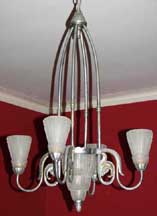 Fine art Deco style
Fine art Deco style
The name "Art Deco" comes from the 1925 Exposition Internationale des Arts Decoratifs Industriels et Modernes, held in Paris, which celebrated living in the modern world.
Fine art Deco was substantially a style of ornament and was practical to jewelry, wear, furniture and handicrafts as well as buildings. Industrial designers created Art Deco motifs (patterns) to beautify their streamlined cars, trains and kitchen appliances. Art Deco ornament consists largely of depression relief geometrical designs, often in the course of parallel directly lines, zigzags, chevrons and stylized floral motifs.
See also: Fine art Deco architecture and Art Deco furniture
- Illustration: Carl Slone Antique Lighting and Windows
- Chandelier, pendant, table lamp, sconce - Hotchkiss-Sidway House
- six hanging light fixtures - Carl Slone Antiquarian Lighting and Windows
- Ceiling calorie-free fixture - Kelly Schultz Antiques
- Pendants, sconces - Pierce-Pointer Showroom
- Outdoor wall sconce - Buffalo Industrial Bank
- Illuminated men'southward room sign - North Park Theatre
- Pendant, sconce - Norton Memorial Hall, Chautauqua, NY
- Pendants - Caf� Americain, American Hotel, Amsterdam, Netherlands
- Sconce - Yard Hotel, Amsterdam, Netherlands
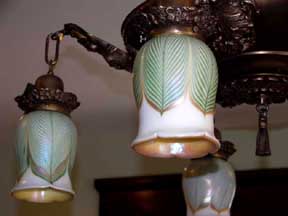 Art Nouveau way
Art Nouveau way
The French "new art" that took bold in Europe and America in the 1890's. The style used flat patterns of twisting plant forms based on nature, sometimes tortured. Information technology was characterized past its use of fluid, sinuous lines and organic, elongated forms. The movement's signature motif was the S-bend, which might exist plant in a flower's stem on a brooch or the trail of smoke from a cigarette depicted in a theater poster.
Sinuous lines, "whiplash" curves, and organic motifs, such every bit plants and flowers, characterized the Art Nouveau way.
The style, which means "new art," gets its name from a pattern shop, La Maison de 50'Fine art Nouveau, which German entrepreneur Siegfried Bing opened in Paris in 1895. The store was one of the major outlets for the glass of Emile Galle, the fine art glass of Louis Tiffany, the jewelry of Rene Lalique, and the article of furniture of Eugene Gaillard and George DeFeure.
In the United States, Louis Comfort Tiffany was a major proponent of the movement.
Art Nouveau shade patterns: Aurene / Drape / Feather, Pulled plumage, Peacock feather / Fishnet / Heart and vine / Leaf and vine / Ribbing / Spider web / Stalactite / Threading
Run across also: Art Nouveau - Architecture and Art Nouveau - Article of furniture
- Illustration: Green pulled feather - Statler House
- Sheffield - Carl Slone Antiquarian Lighting and Windows
- Sheffield - Carl Slone Antique Lighting and Windows
- Pulled feather - Carl Slone Antiquarian Lighting and Windows
- Outdoor sconce - Guaranty Edifice
- Sconce, chandeliers - Guaranty Edifice
Arts and Crafts style 1900-1925
In 19th century England, the Arts and Crafts movement was an outraged response to the Industrial Revolution, which was threatening time-honored manual crafts with extinction. The motion was besides one of social and political reform.
In America, the Arts and Crafts movement, 1890-1920 is often referred to every bit the Craftsman motility.
See too: Arts and Crafts - Compages and Arts and Crafts - Furniture and Art Nouveau ( above )
Best known of the Arts and Crafts lighting styles was Mission, which emerged about 1905 to become lighting's equivalent of the bungalow - unproblematic, honest, accessible and unpretentious. Defined by square forms and lack of decoration, Mission fixtures were found in homes of many unlike styles. The chief legacy of the Arts and Crafts movement in lighting is that it brought together 2 rich and romantic materials - brass and opalescent art glass - in fresh and original ways. Opalescent art glass radiated the glowing warmth of hearth and abode, while contumely was piece of cake to piece of work and took finishes readily (popular ones included brushed, sanded and mottled brass or copper).
The chief legacy of the Arts and Crafts movement in lighting is that it brought together 2 rich and romantic materials - brass and opalescent art glass - in fresh and original ways. Opalescent art glass radiated the glowing warmth of hearth and abode, while contumely was piece of cake to piece of work and took finishes readily (popular ones included brushed, sanded and mottled brass or copper).
More elaborate Arts and Crafts designs might include leaded mosaic glass work, unusual square-link chain or manus-hammered brass lanterns. Even the near bones and straightforward fixtures possessed a progressive and mod sensibility that challenged the Victorian and Colonial Revival condition quo.
Lighting styles of this era included Arts and crafts and Old English, Mission and Craftsman.
- Bo Sulllivan, Illuminating the By
- Illustration: Wright-designed ceiling pendant - Barton Firm
- Pendant, sconces - Barton House
- Sconce - Davidson Business firm
- Wright-designed flooring lamp - Graycliff, Derby, NY
- Buffalo Sconce
- Statler Firm
- Henry Hudson's Ship, Half-Moon, sconces - Carl Slone Antiquarian Lighting and Windows
- Pendants, table lamp - Roycroft Inn, East Aurora, NY
- Tabular array lamp, Steuben ceiling fixture - Elbert Hubbard Roycroft Museum, East Aurora, NY
- Table lamps, sconce - Elbert Hubbard Roycroft Museum, Eastward Aurora, NY
- Outdoor hanging fixture - Risk Firm, Pasadena, California
- Outdoor lamp - Paris M�tro
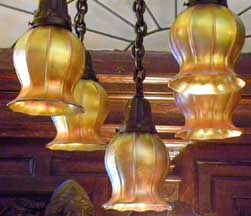 Aurene
Aurene
The name "Aurene" was derived form the Latin word for aureate, "aurum," and the old English language word for sheen or luster, "schene."
Glassmaker Frederick Carder (Steuben founder) invented this brand of ornamental glass in 1904. To produce a murky translucent glass with an iridescent surface, the drinking glass was sprayed with stannous chloride or lead chloride, so reheated. It was the beginning iridescent drinking glass Steuben fabricated, and both the gilt and the blue colors are very similar to glass that was being made past Tiffany and called "Favrile."
Steuben (below) Aurene colors: variations of deep ruby red, pinkish or salmon, light-green, brown
Steuben dark-green Aurene decorations: leaf and vine, cleaved thread, peacock plumage, diamond optic, applied border with zig zag, Murano type wave, copper cycle engraved designs
Steuben dark-brown Aurene shades: from calorie-free tan through orange brown to a dark chocolate brown, many with zig zag decorated border. Some busy with other Aurene colors such as r, blueish, green, gold, or white. Most lined with either white Calcite or alabaster
- Illustration: S igned Steuben sha des - Carl Slone Antique Lighting and Windows
- C. 1900 brass ceiling fixture - Carl Slone Antique Lighting and Windows
- Sheffield - Carl Slone Antique Lighting and Windows
- Craven/Bassett House - Example #1
- Chicken/Bassett House - Instance #two
Blowpipe, blow iron
An iron or steel tube, unremarkably about 5 feet long, for blowing glass. Blowpipes have a mouthpiece at i end and are usually fitted at the other end with a metal band that helps to retain a gather (below).
The Romans discovered glassblowing in nigh fifty B.C.
For more than inforamtion, encounter Illustrated Stained Glass Dictionary: Glassblowing
- Analogy: artwork at Corning Museum of Glass
 Diddled glass / Manus diddled glass
Diddled glass / Manus diddled glass Glass that is fabricated on a blowpipe, formed and shaped by mitt.
To produce glass, a gaffer (below) gathers a glob of molten drinking glass on the cease of a blowpipe. The gaffer inflates the glob slightly by blowing, and and then manipulates it by swinging, rolling or shaping information technology with tools. Then the gaffer inflates the piece to its proper size, possibly within a mold in society to attain a specific shape.
For more inforamtion, meet Illustrated Stained Glass Lexicon: Glassblowing
- Tiffany Blossom-form Vase - Corning Drinking glass Museum
- Roman Egyptian Glassware - Corning Drinking glass Museum
Bracket lamp -- Any variation of lamp designed to be mounted on a vertical surface and extend outward. Many are adjustable side-to-side and swing outward. Brackets tin can exist made of brass, bronze, cast iron, etc. Founts tin exist either metal or glass. Many subclass lamps characteristic reflectors mounted behind the lamp to increase the calorie-free output.
Broken Thread
Run across Zipper beneath
Calcite glass
Colorless or white mineral used in the industry of glass
Perfected nigh 1915. It has a white tone with ivory translucency.
Used for the exterior of cased glass such as "Aurene on calcite."
Canopy
The part of a lighting fixture the mounts to the ceiling. In a pull-downwards hall lamp fixture, the part that hangs from the ceiling and contains the pulleys.
- 1933 Lincoln Manufacturing Co. flashed glass chandelier - Carl Slone Antique Lighting and Windows
Carnival glass
This inexpensive drinking glass with brilliant gilded, orange, and purple iridescence was made in the U.s.a. between about 1895 and 1924. It is and so chosen because information technology was frequently offered as fairground prizes.
Carnival glass is an inexpens ive pressed glass, made every bit both functional and ornamental objects, always iridescent and found in a wide spectrum of colors.
It was produced in the U.Due south., Great britain, Australia, and several European and Asian countries from the early 20th century u ntil the nowadays.
Carnival drinking glass gets its iridescent sheen from the application of metallic salts while the glass is still hot from the pressing, and so re-firing the drinking glass
Chandelier
A ceiling mounted light fixture that has at least one arm branching out from a central support
- 4 chandeliers - Carl Slone Antique Lighting and Windows
- Hagia Sophia, Istanbul, Turkey
- St. Stephen Walbrook
- Courier Express Building
- C. 1800 cut drinking glass, brass chandelier
Chimney
Usually a glass (sometimes mica or even metal) enclosure that helps control the period of air to and around a lamp burner.
Chipped drinking glass
See Mucilage-chipped drinking glass below
Classical Revival/Beaux Arts style 1895-1935
T he 1893 World'due south Columbian Exposition in Chicago introduced many things to the American public, including Cracker Jack candy and the Ferris bicycle, only perchance its almost lasting influence was on compages. Constructed almost entirely in the Classical Revival (or Beaux Fine arts) style, the "White City" signaled the cease of colorful and exotic buildings. Within only a few years, the artful, picturesque, asymmetrical designs of the VictorianGreek and Roman architecture. Classical Revival fixtures were heavy and substantial looking, projecting an aura of permanence and power. These fixtures, as well as the shades that beautify them, can commonly be distinguished by boldly detailed Classical motifs such equally egg and dart, ribbon and bay, acanthus leaf and Greek primal.
In addition, the introduction of the tungsten-filament light bulb around 1910 fabricated more opaque forms of glass feasible, and large indirect and semi-indirect bowl fixtures get popular in dining rooms and other large spaces.
The brass and statuary parts found in Classical Revival fixtures are ofttimes solidly cast and meticulously detailed. Common finishes included polished and brushed brass, likewise as the blue-green patina known every bit verde gris or verde antique.
Lighting styles of this era included Classical Revival, Beaux Arts, Bizarre/Rococo and French/ Italian Renaissance.
- Bo Sulllivan, Illuminating the Past
Colonial Revival way 1905-1940
C olonial Revival lighting besides has a scrap of a split personality. On the one hand, we discover the elegant and sophisticated polished-brass or silvery-plated fixtures enhanced by sparkling crystals and wheel-cut shades, while on the other are the rustic and "mitt-forged" designs that celebrate wrought iron and the blacksmith's hammer.
Either manner, frequent features include chains, dangling finials and sockets that evoke the retention of candles or oil-called-for lamps of the before menstruum.
Lighting styles of this era included Colonial Revival, Sheffield (see below), Georgian/Adam and Late Colonial Revival.
- Bo Sulllivan, Illuminating the Past
Meet Sheffield below
Cadre-forming glass
3 basic ways of forming glass:
Core-formed (ancient systm before glassblowing)
Glassblowing ( above )
Rolling (Cathedral glass)
In the 16th century B.C., western Asian craftsmen made drinking glass vessels by core forming. This process was introduced in Egypt around 1450 B.C.
Core-formed glass was ordinarily opaque ( allowing picayune or no light to pass through).
 [T he Egyptian glassmaker] first made a core of clay combined with dung. He then wound hot glass effectually the core. The glass was reheated and smoothed by rolling it on a apartment surface. Side by side, the glassmaker trailed glass thread of vivid colors - turquoise, blue, yellow, red, white - around the surface and dragged them upwardly and down to form waves or feathery patterns. When the vessel was finished, he picked out the clay core with a pointed instrument.
[T he Egyptian glassmaker] first made a core of clay combined with dung. He then wound hot glass effectually the core. The glass was reheated and smoothed by rolling it on a apartment surface. Side by side, the glassmaker trailed glass thread of vivid colors - turquoise, blue, yellow, red, white - around the surface and dragged them upwardly and down to form waves or feathery patterns. When the vessel was finished, he picked out the clay core with a pointed instrument.
- Chloe Zerwick, "Drinking glass in Pre-Roman Times"in A Curt History of Glass, 1980, pp. 15-16
- Analogy: Core-formed Egyptian Jars - Corning Drinking glass Museum
- Jar, Eastern Mediterranean, perchance Cyprus - Corning Museum of Glass
Custard glass
F irst produced in England around 1880, novelties, salt dips, small-scale baskets, etc., were created in creamy custard glass but information technology was non made in America for about 5 more years. The first American company said to produce custard glass was the Dithridge Company in Pittsburgh, Penn. With all the foam-colored drinking glass on the market, how can you tell if yous've found a piece of genuine custard glass? Buy a small, portable black light and smooth black calorie-free on the piece so you lot'll know for sure whether or not it's custard glass considering the genuine article will take on an unearthly, luminous glow. In custard glass, uranium is what gives the glass its deep cream color. In fact, if you have a Geiger counter handy, you volition also go a positive reading on custard and any other form of uranium drinking glass.
- Source: Tammy Springer
- Carl Slone Antique Lighting and Windows
Drag Loop or Festoon
One of the popular patterns used at Steuben was called Drag Loop . It is found on many shades and vases and is occasionally found on other pieces besides. The pattern is oftentimes mistakenly called a plumage; however it differs from the plume in that the hook used in pulling the hot glass went in one direction only. This leaves no center spine which is formed on the regular feather as a upshot of the claw being pulled one style and and then the contrary. The Drag Loop blueprint is zip more a loop or festoon.
- Darrah L. Roberts, Collecting Fine art Nouveau Shades, 1972, p. 31
Pall pattern
"This motif is really a variation of the pulled plume decoration. The mantle is dissimilar, nonetheless, because it adorns the lesser portion of the shade. The undecorated portion is toward the fitter rim. Likewise, the curtain pattern usually repeated just iv times, while the feather was duplicated 5 times. The gaffer sometimes pulled the glass threads the entire length of the shade." - Darrah L. Roberts, Collecting Art Nouveau Shades, 1972
Electrolier
[Formed from electric in imitation of chandelier.] A branching frame, often of ornamental design, to support electric illuminating lamps.
- Fine art Deco electrolier - Carl Slone Antique Lighting and Windows
Enameled
Engraving
The surface of the glass is decorated by scratching the surface with a rotating copper wheel or a diamond.
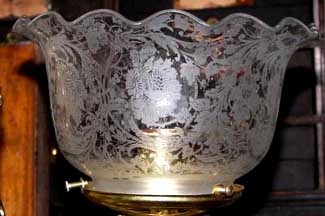 Etching
Etching
Glass decorated by biting out designs or motifs by means of acid practical to unprotected surfaces. The he glass surface is covered with wax, the desired pattern is inscribed in the wax, then hydrofluoric acrid is practical. The acid will only corrode the areas that are non covered by wax. This process produces a flatter pattern than engraving.
A method of producing designs/patterns on glass whereby acids are used to remove office of the drinking glass and make the design.
Traditionally this was done after the glass was blown or cast.
In the 1920s a new mould-etch procedure was invented, in which art was etched directly into the mould, then that each bandage slice emerged from the mould with the image already on the surface of the glass. This reduced manufacturing costs and, combined with a wider use of colored glass, led to cheap glassware in the 1930s, which later became known as Depression glass.
- C. 1880 newel post gas li ght - Carl Slone Antique Lighting and Windows
- Rococo Revival lighting fixture - Carl Slone Antiquarian Lighting and Windows
- Art Nouveau bister scallop border shade - Carl Slone Antique Lighting and Windows
- Fine art Nouveau shade - Carl Slone Antique Lighting and Windows
- Carl Slone Antique Lighting and Windows
- Carl Slone Antiquarian Lighting and Windows
- 216 Metcalfe Street
Feather, Pulled feather, Peacock feather pattern
Colored canes of glass are wound effectually the torso while red hot and molten. and then been combed or "pulled" to create the feather-similar appearance. The eye spine is formed on the regular plumage equally a result of the hook being pulled one manner so the opposite.
The plumage decoration was formed by first spinning a fine thread of colored drinking glass on the partially blown parison [see Shades below]. The threads were spun around and effectually the piece to be busy. They were always separated, however slight this separation may take been in some cases, The parison was reheated at the glory hole of the furnace, so by using a steel hook the gaffer pulled the threads of hot plastic glass into the desired pattern.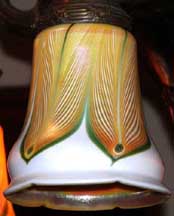 T he pattern near often seen as a ornament on shades is the feather patter n. Thousands of shades were so adorned. This pattern was used by all six of the firms known to have fabricated high quality iridescent shades. A wide range of colors were used, with either green, xanthous, or gilt beingness the most common. Carmine is least ofttimes seen. The names listed to a higher place all describe the same decoration.
T he pattern near often seen as a ornament on shades is the feather patter n. Thousands of shades were so adorned. This pattern was used by all six of the firms known to have fabricated high quality iridescent shades. A wide range of colors were used, with either green, xanthous, or gilt beingness the most common. Carmine is least ofttimes seen. The names listed to a higher place all describe the same decoration.
The piece was returned many times to be reheated so it could be kept in a plastic land and workable. Temperatures were vital for the gaffer [in a higher place] because the shade would pause if an effort was made to work information technology while it was besides cool. Other serious handling issues arose if the shade was overheated.
After the feather was formed the slice was rolled on the steel marvering board which pushed the threads into the main trunk of the shade.
On some shades a contrasting border was formed first, and then the feather was pulled inside this frame.
Shirt Hooked Feather and Brusk Plume : We telephone call information technology a curt plume because it is short and does non cover as much of the outside expanse of the shade as the regular feather blueprint does. - p, 40
- Darrah L. Roberts, Collecting Art Nouveau Shades, 1972, p. 31
- Illustration: Pulled feather with peacock eye - Carl Slone Antique Lighting and Windows
- Chicken/Bassett House - Case #1
- Craven/Bassett House - Example #2
- Tiffany Flower-form Vase - Corning Glass Museum
Fishnet blueprint
The fishnet blueprint is actually nothing more than a double feather ( above ) pattern, one over the other. One of the plumage patterns was pulled in one management while the other was pulled in the opposite way. This can exist seen on close inspection of the marks left past the gaffer's ( below ) claw as the hook traveled both directions in each track. To make the fishnet shade the threads for the underneath half of the decoration were spun on the parison (
- Darrah L. Roberts, Collecting Fine art Nouveau Shades, 197 2, p. 90
Fitter
Generally the lower rim (or lip) of a chimney, globe or shade that that fits into a metal ring, burner or holder. A hall lamp shade, for example, would have a fitter on both ends.
Flashed drinking glass
The process of a glass detail being dipped into hot glass of some other color in such a manner to cause only a thin layer of it to adhere. This is a less expensive method for making a piece of glass appear to have been fabricated in a solid color. This is a blown glass method and is not to exist confused with staining used on pressed drinking glass.
Besides known as plating, flashed drinking glass is sometimes cut through to the thicker layer beneath the flashing. The flashing is probably well-nigh as thick every bit a canvas of paper and can still be scratched through, but not as easily every bit staining.
- Art Deco electrolier - Carl Slone Antique Lighting and Windows
Gaffer
"The gaffer was most skilled and usually in charge of a store. He was the worker who pulled the hot plastic glass into the various shapes such as King Tut, plumage (beneath) and other pulled decorations and who did the final shaping of the slice." - Darrah L. Roberts, Collecting Fine art Nouveau Shades, 1972
Gather/gob
(Substantive) A mass of molten glass (sometimes called a gob) nerveless on the terminate of a blowpipe [in a higher place] or gathering iron;
(verb) to collect molten glass on the end of a tool.
- Illustration: 2009 sit-in at Corning Drinking glass Museum
Drinking glass
Glass is a hard material with not-crystalline, random construction like a liquid. It is ordinarily made past combining materials such as silica, potash, and lead oxide at a high temperature in social club to allow the materials to melt and fuse together. When cooled rapidly, the substance becomes rigid . Drinking glass is often classified as a supercooled liquid rather than a regular solid.
Glass is made with very bones ingredients. Sand is the main ingredient, and and so added to that are ashes from copse or plants which help the sand to melt. Something like lime is besides added which is a stabilizing ingredient, and it protects the glass from wet.
Nigh the same recipe as that given on a cuneiform tablet of the seventh century B.C. is in use today.
No one really knows how glass came to be made. it is older than the Ten Commandments and probably originated somewhere in the Middle East. it was adopted by the Romans, who contributed significantly to its evolution; information technology flowered under the Islamic empire; and it reached new heights in Renaissance Venice, whence information technology spread throughout Europe and eventually to America.
- Chloe Zerwick, A Curt History of Glass, 1980, Introduction
3 basic ways of forming glass:
Core-formed (aboriginal systm earlier glassblowing; above )
Glassblowing ( above )
Rolling ("Cathedral glass"
Glue-chipped glass
| "Glue chipped glass is glass that has been etched and covered in warm, wet hibernate gum. Every bit the mucilage cools, it attaches to the rough glass. As it dries, it shrinks and rips sparse shards off the surface in a fern-like random pattern." - AngelGilding.com (June 2011) "...surface of the glass is chipped by the controlled action of a particular type of hide glue. The texture looks similar water ice crystals on glass in wintertime and is used as a striking decorative effect equally well as to block the view through a piece of glass without blocking out light." - Etch Master (June 2011) "A unique surface texture created by applying a sparse layer of animal hide glue to a cathedral glass and then heated in an oven. As the mucilage dries it pulls away from the drinking glass surface and chips information technology. Unlike patterns created include single, double, and oceanic. The texture is oftentimes described as feathered or like frost on a window pane." - The Shop Finder (June 2011) Analogy: Temple Beth Zzedek |  |
Gone With The Wind Lamp
By and large a vase or parlor lamp with a removable fount and matching painted or embossed decoration on both the lamp base and shade.
Gothic /Gothic Revival
Centre and vine motif
Hob nail
The discussion hobnail probably comes from the first surname in Hobbs, Brockunier & Company, from S Wheeling, West Virginia, the visitor that first patented the raised bumps. Their hobnail pieces are the near famous ones from the late 19th century. The company would sometimes advertise the pattern with other names, such equally nodule, dewdrop, or pineapple, but hobnail has become the popular term for the glass. The pattern went out of manner in the offset half of the 20th century, merely was revived from the 1940s to the 1970s by companies such as Duncan Miller and the Fenton Drinking glass Visitor; the latter is still in business organization today. Other companies that have offered hobnail patterns were Millersburg, West Moreland, L.G. Wright Visitor, and Imperial.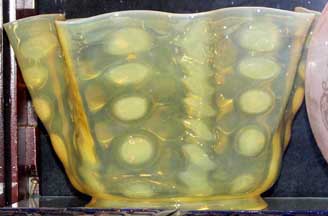 S ome people identify hobnails as large-headed nails used to protect the sole of a heavy kick or shoe. But in the world of glass, the word " hobnail ," sometimes spelled "hob nail," has a very different meaning. "People refer to the hobnail pattern equally 'the little things that stick out on a slice of glass,'" says Kathleen Bailey , an ANTIQUES ROADSHOW appraiser and dealer based in Seattle and Issaquah, Washington. "The easiest way to draw information technology is as glass that has footling bumps over most of its surface."
S ome people identify hobnails as large-headed nails used to protect the sole of a heavy kick or shoe. But in the world of glass, the word " hobnail ," sometimes spelled "hob nail," has a very different meaning. "People refer to the hobnail pattern equally 'the little things that stick out on a slice of glass,'" says Kathleen Bailey , an ANTIQUES ROADSHOW appraiser and dealer based in Seattle and Issaquah, Washington. "The easiest way to draw information technology is as glass that has footling bumps over most of its surface."
- Antiques Roadshow
One popular blazon of hob blast style on lamp shades is found on milk glass.
- Analogy: Hand blown canary yellow - Carl Slone Antique Lighting and Windows
- Hand blown red - Carl Slone Antique Lighting and Wind
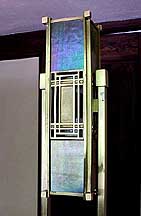 Irised
Irised
Showing a changeable rainbow of colors.
Non a surface texture, but a special surface cease. Finish produces a metallic sheen creating a colorful, shimmering, rainbow effect. Glass with a colorful shimmering issue created when a layer of metallic oxide is bonded to hot glass.
Tiffany had his "Favrile" drinking glass and Carder developed a similar line he called "Aurene," only other glassmakers followed their atomic number 82 and likewise produced iridized glasswares.
- Illustration: Sconce - Barton Business firm
- Some other sconce - Barton House
- Tiffany shade - Private collector, Buffalo
- Tiffany Flower-course Vase - Corning Drinking glass Museum
Jeweled
Whatsoever lamp or component part (such as a hanging lamp frame) that is adorned with cut or faceted colored glass cabochons.
- Ceiling fixture - Carl Slone Antiquarian Lighting and Windows
King Tut pattern
The blueprint consists of threads of glass, ordinarily of a contrasting color, beingness hooked or pulled in a swirl blueprint on the outside of the piece. Usually the motif was repeated twenty to xl times until it covered the entire outside of the shade. Withal, in some cases it was restricted to two-thirds or three-fourths of the expanse, with the remaining portion either left plain or adorned with a Cleaved Thread or zipper ( The threads of glass used must take, at times, been quite fine, where equally many as twelve dark-green threads in a quarter inch area can be counted and yet show separation when viewed with a magnifying glass. This would suggest that at the time the thread of drinking glass was applied, it must not have been much larger in diameter than a human hair. The threads would naturally be further broadened when flattened out during the marvering ( T he Male monarch Tut ornamentation is certainly one of the most popular and sought-after motifs to be plant on fine art glass today.
T he Male monarch Tut ornamentation is certainly one of the most popular and sought-after motifs to be plant on fine art glass today.
In add-on the shade may have been decorated while it was smaller and this would tend to expand the thread more than when it was diddled to its last size. The King Tut decoration demanded a concrete dexterity that only a few gaffers were able to really chief well. It was executed at its finest past Emil J. Larson who made his version of the design famous while working equally a gaffer at Durand.
- Darrah L. Roberts, Collecting Art Nouveau Shades, 1972, p. 29
- Illustration: Tiffany shade - Private collector, Buffalo
Lantern
A lighting device, commonly used outdoors, that utilizes a world to protect the flame from current of air and the elements. About often carried from place to identify, thus of fairly rugged construction.
Leaded glass
Glass objects in which pb is used to solder together carve up pieces of glass together into a larger whole. Most early stained glass is leaded.
Foliage and vine decor, Clinging vine (Durand Co. name)
I f one company were to be singled out as the 1 producing the finest commonly seen Leaf and Vine decoration, it would be Steuben and by an overwhelming margin... Characteristically, the Steuben Leaf and Vine is a ane-color motif. If the leaf is gold the vine is also gold. This dominion is good for all of the other colors in which Steuben's Leaf and Vine is known, such equally blue, platinum, green, and white... Earlier the decorating of a leaf and vine shade could begin, a rod of glass of the color to be used was prepared for the gaffer. Several thin slices were cut from this glass rod and practical to the body of the shade in random positions. The shade was reheated often during this process, with the gaffer pulling down through each leaf with his steel hook to grade the heart-shaped leaves. The completed leaves were then rolled in flush, or they might be left largely unmarvered, if that was desired. The fine thread of drinking glass intended as the vine portion of the decorations was and then spun on over the leaves and this was either marvered in or left equally it was spun on. This is one thing Steuben did consistently when making Leafage and Vine decorated shades; the leafage was applied get-go and and so the vine was applied over the leafage.
- Darrah L. Roberts, Collecting Art Nouveau Shades, 1972
Curtain
A specially made 'tube' or cone of treated material that produces an incandescent glow when heated past a kerosene or gas flame.
Marvering, Marvering lath
Marvering is the pre-shaping of the drinking glass gathered on the preheated end of the bravado fe (above). This pre-shaping is carried out by rolling the glass backwards and forwards beyond a marvering tabular array (or marver plate), adjusting the angle of the blowing iron to give the approximate shape desired.
Marvering board: A metal or wooden tabular array or slab - which was wax or oil coated for lubrication - on which the gob or assemble ( above ) drinking glass at the stop of the blowpipe could be rolled to give the judge shape desired.
Miller (Edward) & Company
 E dward Miller started his concern in Meriden, Connecticut, in the 1840's making and selling camphene and called-for fluid burners.
E dward Miller started his concern in Meriden, Connecticut, in the 1840's making and selling camphene and called-for fluid burners.
When Colonel Edwin 50. Drake struck oil in Titusville in 1859, kerosene rapidly became a rubber and affordable lamp fuel. Miller envisioned an immediate demand for burners for the new fuel and seized the opportunity.
In 1868, Miller constructed a brass rolling mill to keep up with his company's need for brass Equally gas became a viable fuel source for cooking, heating and illumination, Miller entered into the manufacture of gas lighting fixtures and stoves. As the age of electricity beckoned, Miller followed the trend, or more than appropriately, blazed new trails. He improved upon Thomas Edison's carbon filament lamp by designing a tungsten filament lamp. Miller pioneered mercury vapor and fluorescent lighting systems in the belatedly 1930's besides. Starting around 1884 through 1892, Edward Miller & Company manufactured the "ROCHESTER" line of lamps for The Rochester Lamp Visitor, located in New York City. They billed themselves every bit "The largest wholesale and retail lamp store in the world," with branch stores in London, Paris and Chicago. Edward Miller produced, according to the catalog, 2000 designs and of variations of the Rochester, and in every manner of lamp - table, hanging store lamp, hanging library lamp, pull-down hall lamps, bracket lamps, dark lamps, and more. Edward Miller died in 1909 at the age of 82. The Miller Company is still in existence today.
- The Lampworks
- Analogy: Aptitude console table lamp - Carl Slone Antique Lighting and Windows
- Four table lamps - Carl Slone Antique Lighting and Windows
- Poster
Mold blown glass
Glass that is formed by existence blown into a shape or blueprint mold, non free-formed.
Mold Marks :Seam lines that remain on the body of the glass after information technology is removed from the mold.
- Illustration: 2009 sit-in at Corning Glass Museum
Mushroom shade
- Art Deco electrolier - Carl Slone Antique Lighting and Windows
Newel post low-cal
Opalescent
Exhibiting a milky or pearly iridescence similar that of an opal.
See American opalescent glass - LaFarge and Tiffany
Parison
The assemble [ above ] of hot glass after it has been partly or wholly inflated by the glass blower .
Patina
The sheen on whatever surface, produced by age and use .
- C. 1900 brass ceiling fixture - Carl Slone Antiquarian Lighting and Windows
- C. 1880 newel post gas light - Carl Slone Antiquarian Lighting and Windows
Pendant lighting
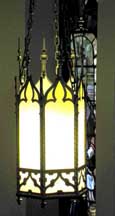
P endant lights are any lights that hang from a ceiling, whether they hang over a kitchen island or a dining room table.
Pendant lights tin can cast directly light or lengthened light, and tin can be decorative or utilitarian.
Many pendant lights, such as chandeliers, have several branches.
- Lighting Fixture Glossary
- Episcopal Church of the Ascension Gothic Revival style
Pot
A fired clay container placed in the furnace in which the batch of glass ingredients is fused, and kept molten. The drinking glass worker gathers directly from the pot.
Pressed glass
Glassware formed by placing a blob of molten glass in a metal mold, then pressing it with a metallic plunger to grade the within shape. The resulting piece, termed "mold-pressed," has an interior form independent of the outside, in contrast to mold-blown glass, whose interior corresponds to the outer course.
Prisms
Dangling drinking glass pendants used to embellish a lamp. Oft of high quality glass, cut and faceted, to reflect and refract the light. Establish on many hanging library/parlor lamps, on girandoles, and overlay lamps, to proper name a few.
Pulled feather shade
Run into Plumage above
Quezal Art Glass Visitor
T he Quezal Art Drinking glass and Decorating Company was established in Brooklyn, New York, in 1901, and was in operation until about 1924. The primary officeholder was Martin Each who had learned how to make irised (above) glass while working at the Tiffany glass works. The company was successful in creating excellent examples of Art Nouveau (above) glassware and probably produced more shades than whatever other business firm. The Quezal visitor took their name from the colorful South American Quezal bird. The name was chosen considering of the similarity in coloration between the bird and the glass made by Quezal. The production of shades at Quezal was large. Shades are known to take been made in every color and in about every known ornamentation, shape, and size. Sizes range from the smallest lily and similar miniatures upwards to large ornate ceiling fixtures which hold very large shades. The workmanship shown on most Quezal shades is excellent. This is especially true of those which have an engraved signature. Many shades are adorned with difficult-to-brand motifs such every bit King Tut, hooked feather, zipper, fishnet, applied flowers, and some "pulled" decors which were specially pleasing. Quezal also made shades which had the ornament embedded in articulate glass.
- Darrah L. Roberts, Collecting Fine art Nouveau Shades, 1972
Quezal was considered to be a major rival of Louis Comfort Tiffany's glass every bit they produced iridescent glass which was widely regarded to be of the same high quality every bit Tiffany's glass.
See also:
- Malcolm Neil MacNeil, Quezal art drinking glass, part 1
- QUEZAL Drinking glass Information & HISTORY
Rococo / Rococo Revival styles
Rococo: Ornate manner originating in France in the 18th century and evolving from the Baroque style
Rococo Revival: Introduced to America around 1840 and remained dominant throughout the 1860s. Although it is based on the 18th-century European Rococo fashion, it is much bolder than its model. Ornament is carved in higher relief, and decorative detail is unremarkably far more realistic.
Run across besides: Rococo / Rococo Revival - Furniture
- 1850 brass four-arm - Carl Slone Antique Lighting and Windows
Shades
The Making of an Art Nouveau Shade
A ll paw diddled, iridescent, Art Nouveau style glass was made past a group of workers in what was chosen a "shop." The larger operations, such as Tiffany Glass Company, may have had two or three shops in operation at the same time while minor firms such every bit Lustre Art and Durand just operated one store. The crew needed for making shades or vases consisted of the following glass workers:
The gaffer [A master craftsman in charge of a team of hot-glass workers, probably coming from "grandfather"]
The decorator or servitor
The blower and sometimes an assistant
The gatherer
The carry-in boy or boys
The gaffer was almost skilled and usually in charge of a shop. He was the worker who pulled the hot plastic drinking glass into the various shapes such equally Male monarch Tut, plume (below) and other pulled decorations and who did the final shaping of the slice.
[First:] A shade began as a gather (above) of glass on the terminate of the blow iron (above). If a cased shade was planned, the gatherer started with a lining, dipping this into the different pots of colored metal (molten glass), in succession, to form the base of operations glass and overcoat. Sometimes the baseglass or overcoat was prepared in advance in cup shape, and the glass used for the lining was blown into this, making the cased parison [partially blown].
[Decoration:] If the shade was to be decorated, it was done at this time. The decoration consisted of a thread of hot glass, ordinarily of a contrasting color, applied to the exterior of the partially diddled shade, which was probably in bullet shape at this stage. The threads of glass were and then pulled with a steel hook into diverse decorations .... Certain decorations, such as Spider Webbing, were not washed until the shade was blown to its total size.
After the decoration was complete the shade was reheated at the celebrity hole of the furnace and diddled to its total size. Sometimes the shade was blown first into a mold which formed it into the desired shape. Then it was removed and blown further to its last size.
[Fitter rim:] Forming the fitter rim was the next step. This was done by trimming the outer end and forming a flange by the use of the usual glassworking tools. (This had to be 2 1/iv, inches in bore, give or take an eighth inch, if the shade was to have a standard size fitter rim.) No standard tool was used in doing this task, then each shade was likely to have a fitter rim of slightly different size and shape. [Shade bottom:] The piece was then transferred to the pontil rod by sticking the recently completed fitter rim on a small get together of molten glass attached to the end of the rod. The accident iron end of the slice was and then cutting off or trimmed to form the lesser rim of the shade. This end was so often notched or ruffled past pushing the hot shade in a crimping die of the proper- shape and size. The crimping on some shades, especially some Quezals, appears to take been done one crimp at a time since they are unevenly spaced. This left each shade slightly different. [Iridescence:] The shade was at present ready to receive its iridescence (above). It is our honest belief that no 1 knows exactly how this was accomplished at that fourth dimension. We do know that the matrix of which much high quality drinking glass was made is the principal difference betwixt it and the cheaper imitations. The metallic properties placed in the matrix came to the surface of the drinking glass and were seen for the kickoff time when the piece was held in a reducing flame, Information technology is as well known that the shade or vase was sprayed with some substance (peradventure metallic chloride) which fractured the surface of the drinking glass into millions of small, low-cal-reflecting facets which we meet as iridescence. This was washed while the shade was hot. In addition, information technology is known that some shades were given a fuming treatment of specially formulated gases or vapors which give them a detail iridescence. Other methods may take been used besides. If the exact method of making this glass was common knowledge, nosotros would probably be plagued with reproductions today. Such articles, however, would become almost time consuming and costly. Wages and other costs at present aren't what they were in 1910. The shade was finally held past asbestos-lined tongs, snapped off of the pontil rod and carried into the tempering lehr [a special type of oven or kiln used specifically for annealing drinking glass] where it was cooled slowly to relieve the internal stresses in the drinking glass. When the shade was absurd, the fitter rim was ground down to remove whatever roughness left past the pontil rod or to remove any other unevenness. Some shades were then given an acid finish which had the effect of satinizing the glass. After a terminal inspection the shade was ready to exist placed in inventory and offered for sale.
- Darrah L. Roberts, Collecting Art Nouveau Shades, 1972, pp. 29-30
Era: 1900 - 1925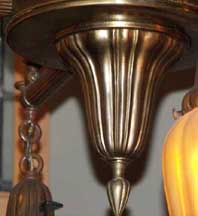 Sheffield way
Sheffield way
First introduced past American lighting manufacturers around 1900, the graceful lines and distinctive shell-similar ribbing of the Sheffield style strongly evoke the work of expert Colonial metalsmiths. An early on Colonial Revival motif. And not being tied to any specific architectural style, it works well in a variety of menstruation and menstruation-inspired homes.
- Analogy: Carl Slone Antique Lighting and Windows
- Carl Slone Antique Lighting and Windows
Slip fit shades
- Fine art Deco chandelier - Carl Slone Antiquarian Lighting and Windows (second row)
Later trailed vessels included objects that were decorated earlier they were diddled to their full size and shape. The trails were dragged up and downward with a too Snake-thread ornamentation
Snake-thread ornamentation
In the Roman era, drinking glass objects were sometimes decorated with trails of molten drinking glass. These trails were applied in curved, snakelike designs. They were and so worked with tools to produce notches or crisscross patterns.
- Illustration: Egyptian Glassware - Corning Glass Museum
Spider Webbing
This method of decorating a piece of art glass was used by at least iii of the firms that made high quality iridescent shades and vases.
Although the design was used years before past both Quezal (
to a higher place ) and Lustre Art, it was left to Durand to name it. They called it Spider Webbing.The Spider Webbing motif consists of a fine thread of glass which was spun around and around the piece until information technology covered most of the area on the outside of the shade or vase. The threads of drinking glass were usually quite fine and were ofttimes placed over a foliage (
above ) or feather ( to a higher place ) blueprint of some kind. The fine threads were left as they were spun on and were non marvered in.Spinner motion lamp
A spinner bearing is a minor piece that fits in the center superlative of the inner spinner in the motion lamp. Information technology is smaller than a dime. Information technology sits on the needle-like spinner mail service, just over the light bulb. The inner-spinner begetting is commonly present, merely on many older lamps it is missing. With No Bearing, the lamp only will not spin. Bearings can exist replaced.
- Colonial Fountain - Carl Slone Antique Lighting and Windows
Stained drinking glass
A process of coating a piece of glass with a chemical whose true color is adult by heat. This is the least expensive way of coloring glass.
The staining fabric is painted on the annealed [cooled] article with a castor wherever the decorative outcome is desired. It is so fired on for permanency at which fourth dimension the glass assumes the desired color.
Stalactite shades, globes, bulbs
Shape imitates cave stalactites.
Art Nouveau ( above ) or Art Deco ( above )
This design is blown and formed straight into the glass and is non painted on.
Tiffany Studios was one of the companies that fabricated some Stalactite chandeliers.
Steuben Drinking glass Co.
 F ounded in 1903 by English glassmaker Frederick Carder, Steuben is an American visitor named subsequently Steuben County, New York, where our blueprint studio and sole glassworks facility are even so located.
F ounded in 1903 by English glassmaker Frederick Carder, Steuben is an American visitor named subsequently Steuben County, New York, where our blueprint studio and sole glassworks facility are even so located.
The company was acquired by Corning Drinking glass Works (now Corning Incorporated) in 1918, and in 1933, Arthur A. Houghton, Jr. was appointed Steuben's president. Soon after, he revolutionized the fine art drinking glass industry with the introduction of clear Steuben crystal -- a new optical drinking glass of unparalleled brilliance and purity formulated by Corning Glass Works scientists.
- Steuben Glass Co. - Official Home Folio
Tiffany had his "Favrile" glass and Carder developed a similar line he called "Aurene," but other glassmakers followed their atomic number 82 and besides produced iridized (to a higher place) glasswares.
- Illustration: Signed aurene shades - Carl Slone Antique Lighting and Windows
- Ceiling fixture - Elbert Hubbard Roycroft Museum, East Aurora, NY
Tudor Revival mode
Victorian styles 1880-1910
V ictorian lighting was defined by the two leading trends of the day - technology and a sense of taste for ornament. As the chief light sources were dim gas burners and carbon-filament bulbs, fixtures were ofttimes multi-arm diplomacy with numerous sockets or jets to maximize light output. Until about 1910, electricity was expensive and poorly distributed, so "combination" fixtures that used both gas and electricity were common. Most fixtures were turned on or off straight at the fixture and hung quite low relative to today's standards
.
Like the houses in which they hung, Victorian fixtures tended toward elaborate and graceful designs that aspired to be "artistic and beautiful" - the highest compliment of the day. Most utilized finely detailed decorative-glass shades that enhanced the light without obscuring it. Fixtures were synthetic of polished brass or bronze, often finished in gilt, silver-plate or rich antiqued treatments.
. Lighting styles of this era included Renaissance Revival, Romanesque (Medieval), Aesthetic/Anglo-Japanese, Empire, Exotic, Fine art Nouveau and Victorian Colloquial.
- Bo Sulllivan, Illuminating the Past
Zipper, Broken Thread pattern
The Broken Thread pattern was made in the following fashion: The partially blown The partially completed shade was then reheated, causing the fine threads to break and draw upwardly on each rib; somewhat as taffy or sugar frosting will pause and describe upwardly when pulled or tested. The shade was and so rolled on the marvering board ( The decorating process was then complete, and the gaffer could reheat the piece and continue on with the farther blowing, shaping, trimming, and forming of the shade. A broad rib would outcome in a broad zipper line, and a sharp rib would result in a fine line of broken threads. If you study a zipper shade carefully yous can see where the drinking glass thread drew upward after breaking, resulting in a ball at one finish of each zipper. Sometimes the zipper ornament was placed over some other decoration. This was more hard because the ribs had to be formed in over the marvered-in threads. Nigh of the decorations found on shades are "pulled," but the Broken Thread or "attachment" pattern is ane of the few that differs from this technique.
Nigh of the decorations found on shades are "pulled," but the Broken Thread or "attachment" pattern is ane of the few that differs from this technique.
- Illustration: Carl Slone Antiquarian Lighting and Windows
rodriguescamen1995.blogspot.com
Source: https://buffaloah.com/f/glos/lighting/vocab.html
0 Response to "Antique Art Noveau Yellow Glass and Brass With Cut Glass Lamp"
ارسال یک نظر